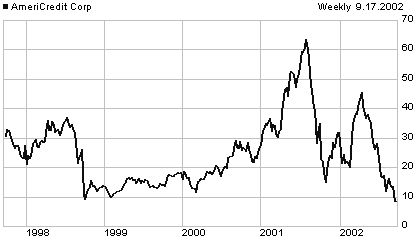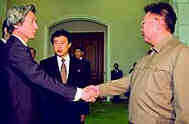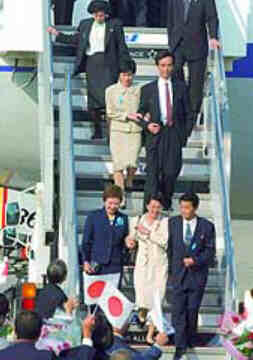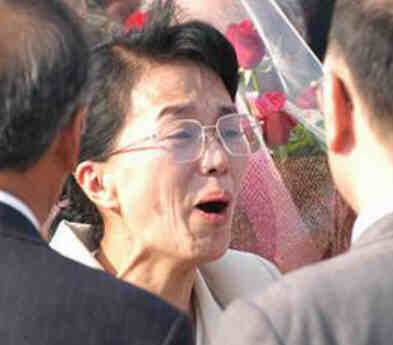Deaths
which occurred on a 17 September:
^top^
2003 Holly
Patterson, 18, of Livermore, a suburb of San Francisco, California.
2003 Harold Kilpatrick Jr., 26, at 22:00 shot by police
who are rescuing the dozen hostages Kilpatrick had been holding since 13:00
in a classroom at Dyersburg State Community College, Tennessee, after leaving
at home a note saying "I want to kill some people and die today." Two hostages
are injured. Kilpatrick was a mental patient, not taking his medication,
and was due to appear in court on previous charges of assault and kidnapping.
2003:: 45 Maoist rebels and 6 government soldiers, in fighting
near Bhawang village, Nepal. A 7-month cease-fire ended in August 2003 with
the break-down ofpeace talks between the government and the rebels, who
have been fighting since 1996 to abolish Nepal's constitutional monarchy
and set up a Communist state.
2002
David Buhbut, 67, Israeli from the Ma'aleh Adumim enclave settlement,
shot in the head after being beaten, by three Palestinian acquaintances
who had lured him to a meeting in al-Azana, adjacent to Ma'aleh Adumim in
Area B of the West Bank (under Israeli control), in the evening. The Palestinians
are later arrested by Israeli police and confess.
2002 Tay-lah
Armstrong, 2, at the Gold Coast Hospital in Brisbane, Australia,
from health problems she had from birth and not related to her surgical
separation at age 6 months, in October 2000, from Monique Armstrong to which
she was born conjoined at the back of the head by a piece of bone the size
of a 50 cent piece. Monique was discharged from the hospital one month after
the operation.
2002 Jesse Patrick, a White, by lethal
injection in Texas for the 1989 robbery, assault, and murder Nina Rutherford
Redd, 80, of Dallas, on a night of which Patrick, a chronic drunk and drug-addict,
claimed to have no recollection.
2001 Abdul Salam Elayyan,
35, mentally ill Palestinian, shot by Israeli soldiers as he approaches
the Egyptian border near Rafah.
2001 Muhammad Ramadan,
21, Palestinian, from wounds suffered from Israeli gunfire during Isreaeli
incursion into Beit Hanoon on 15 September 2001
2001 Muhammad
Shawani, 37, Palestinian security officer, from wounds suffered
on 13 September during Israeli incursion in Jericho.
2000
Mensah Kpognon, UN refugee worker, killed and a second UN refugee
worker, Sapeu Laurence Djeya, kidnapped in a raid in Guinea (he is later
released).
2000 Cruz Martínez Esteruelas, político
y abogado español.
1999 Leonard
Carlitz, mathematician
1996. Spiro T. Agnew,
77, died in Berlin, Md., disgraced former US Vice President under later
disgraced President Nixon.
1995 Georges Canguilhelm,
filósofo francés.
1994 Karl Popper, filósofo británico
de origen austríaco.
1980 Anastasio Somoza Former
Nicaraguan President, assassinated in Paraguay
1974 André
Albert Marie Dunoyer de Segonzac, French painter and etcher born
on 06 July 1884. — MORE
ON DE SEGONZAC AT ART “4” SEPTEMBER
— LINKS
— La
Ferme dans la terre — La
Route de Grimaud — Le
Gros Chêne à Chaville (etching) — Préparation
d'Artillerie — Nature
morte au chou
1965 Alejandro Casona, dramaturgo
español.
1961 Adnan Menderes, 62, PM of Turkey (1950-60)
1959 Some 2000 by typhoon in Japan and Korea.
1948 Count Folke Bernadotte UN mediator for Palestine,
assassinated in Jerusalem by Jewish extremists — Le comte Folke Bernadotte
est tué à Jérusalem, alors qu'il tentait de ramener la paix entre les israéliens
et les arabes, en sa qualité de médiateur des Nations Unies.
1928
Some 2000 drowned as hurricane hits Lake Okeechobee, Florida.
1917 Anton Stadler von Toni, Austrian artist born on 09
July 1850.
1908 Thomas Selfridge, first aircraft accident
fatality ^top^
During an airplane demonstration at
Fort Myer in Arlington Heights, Virginia, a propeller blade came loose
on a plane piloted by Orville
Wright, plunging the aircraft 50 meters to the ground. Lieutenant
Selfridge of the US Signal Corps, a passenger on the plane, died of
a skull fracture, while Orville suffered multiple hip and leg fractures.
Selfridge was the first fatality in an airplane accident. |
1903 Some 10'000 civilians in Kastoria, Bulgaria, as Turks
destroy the town.
1891 Petzval,
mathematician
1885 Lucas Schaeffels, Belgian artist
born on 06 April 1824.
1879 Eugène Emmanuel Viollet Le Duc,
arquitecto y crítico de arte francés.
1877 Talbot,
mathematician
1868 Chief Roman Nose, many Cheyenne and
Sioux braves, and a few of the US volunteers they attack
^top^
The Battle of Beecher's Island begins,
in which Major George "Sandy" Forsyth and 50 volunteers hold off 500
Sioux and Cheyenne in eastern Colorado.
Early in the morning, a large band of Cheyenne and Sioux stage a surprise
attack on Major George A. Forsyth and a volunteer force of 50 frontiersmen
in Colorado. Retreating to a small sandbar in the Arikaree River that
thereafter became known as Beecher's Island, Forsyth and his men succeeded
in repulsing three massed Indian charges. Thanks to the rapid fire
capability of their seven-shot Spencer rifles, Forsyth's volunteers
were able to kill or wound many of the Indian attackers, including
the war chief Roman Nose.
But
as evening came and the fighting temporarily halted, Forsyth found
he had 22 men either dead or wounded, and he estimated the survivors
were surrounded by a force of 600 Amerndians. The Whites faced certain
annihilation unless they could somehow bring help. Two men—Jack Stilwell
and Pierre Trudeau—volunteered to attempt a daring escape through
the Indian lines and silently melted into the night.
The battle raged for five more days. Forsyth's effective fighting
force was reduced to ten men before the Indians finally withdrew,
perhaps reasoning that they had inflicted enough damage. Far from
help and lacking wagons and horses, Forsyth knew that many of his
wounded would soon be dead if they didn't get help. Fortunately, on
September 25, the 10th Cavalry—one of the Army's two African-American
units nicknamed the "Buffalo Soldiers"—came riding to their rescue
with a field ambulance and medical supplies. Miraculously, Stilwell
and Trudeau had managed to make it through the Sioux and Cheyenne
and bring help. Thanks to their bravery and the timely arrival of
the Buffalo Soldiers, the lives of many men were saved. |
1863 baron Alfred-Victor de Vigny, French poet, dramatist
and novelist born on 27 March 1797. — DE VIGNY ONLINE: (images de pages):
Poëmes
; Héléna ; le Somnanbule ; la Fille de Jephté ; la
Femme adultère ; le Bal ; la Prison, etc. — Théâtre.
— Les
destinées : poèmes philosophiques — Poésies
— Les
consultations du docteur Noir : première consultation : Stello
— Servitude
et grandeur militaire — Cinq-Mars
ou Une conjuration sous Louis XIII — (texte): Les
consultations du docteur Noir ; Stello : première consultation ;
Daphné : seconde consultation du docteur Noir ; ... |
 On
a 17 September:
On
a 17 September:  During talks in Pyongyang with Japan's Prime Minister Junichiro Koizumi,
aimed at normalizing relations, North Korean dictator Kim Jong Il, desperate
to get economic aid from Japan, confesses that North Korean secret services
have abducted 11 Japanese in past years (number later increased to 13),
supposedly so as to have them as Japanese language instructors and/or to
assume their identities. Kim states that those responsible have been punished,
and that such abductions will never happen again.
During talks in Pyongyang with Japan's Prime Minister Junichiro Koizumi,
aimed at normalizing relations, North Korean dictator Kim Jong Il, desperate
to get economic aid from Japan, confesses that North Korean secret services
have abducted 11 Japanese in past years (number later increased to 13),
supposedly so as to have them as Japanese language instructors and/or to
assume their identities. Kim states that those responsible have been punished,
and that such abductions will never happen again. 

